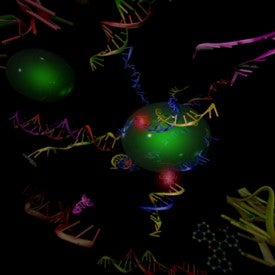
Nov 24, 2015 – Mimicking nature’s photosynthetic processes might be considered a Holy Grail in scientific energy transfer research. To achieve artificial photosynthesis, scientists typically arrange chromophores (special molecules that convert light into excitons, which are packets of energy in the molecules) into systems that funnel excitons down an energy gradient. While this achieves control over the flow of excitons (like electrical current in a wire), the energy gradient results in energy losses at each step of the process (the molecules heat up!). A recent publication in New Journal of Physics by Boise State University undergraduate researcher Donald L. Kellis (Materials Science and Engineering) and co-workers demonstrates an excitonic transfer system whereby lanthanide doped nanoparticles are utilized to ratchet up excitonic energy, a process known as upconversion. With this process, photosynthetic systems can harvest low-energy infrared photons, which would normally be lost. In addition, the researchers implemented their approach using DNA, which means they can controllably switch the system between on and off states using programmable DNA reactions. While more work is necessary to optimize the system, the results from this study provide a new tool for controlling energy flow at the nanoscale.
As a member of the Nanoscale Materials and Device Group, Mr. Kellis is part of a multidisciplinary team of students, faculty, and staff from across the Boise State University campus, his co-authors for this journal publication are undergraduate student Sarah M. Rehn (Chemistry), Ph.D. student Brittany L. Cannon (MSE), Dr. Paul H. Davis (MSE), and Professors Elton Graugnard (MSE), Jeunghoon Lee (MSE & Chemistry), William B. Knowlton (MSE & ECE), and distinguished research fellow Bernard Yurke (MSE & ECE).